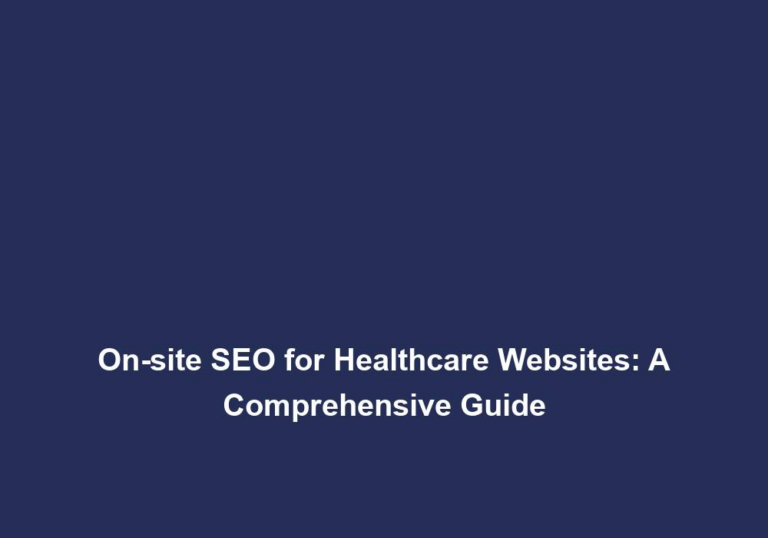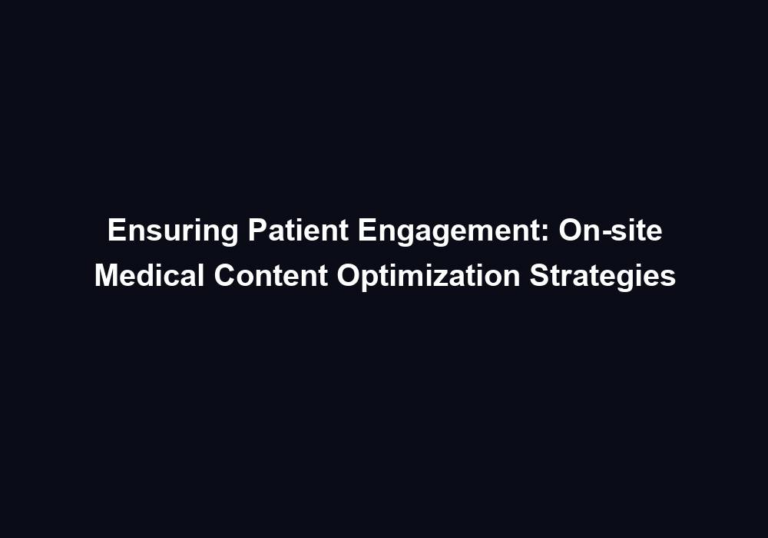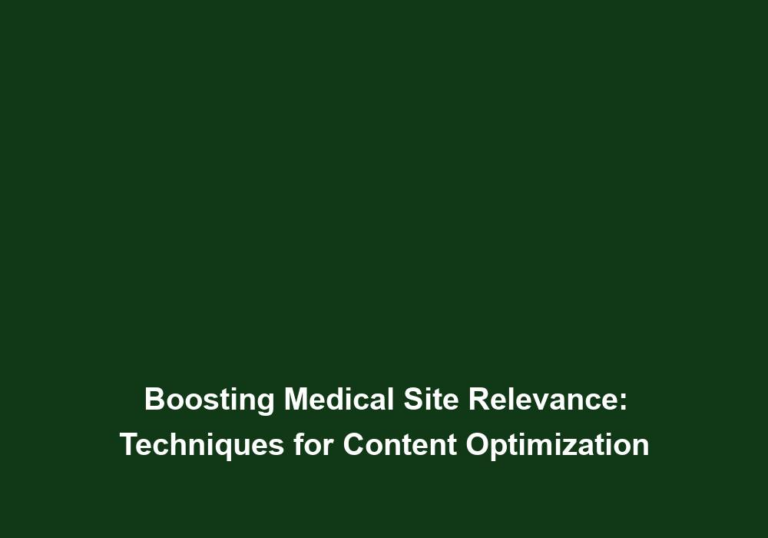Crafting SEO-friendly Medical Content: Best Practices for Optimization
In today’s digital age, having a strong online presence is crucial for any business or industry, and the medical field is no exception. With the constant increase in online searches for medical information, it is imperative for healthcare professionals to optimize their content for search engines. This practice, known as Search Engine Optimization (SEO), helps websites rank higher in search engine results pages (SERPs) and attracts more traffic. In this article, we will discuss the best practices for crafting SEO-friendly medical content to ensure maximum visibility and reach for healthcare websites.
Understanding the Importance of SEO in the Medical Field
Before diving into the best practices, it is essential to understand why SEO matters in the medical field. With the rise of online healthcare information-seeking behavior, patients and consumers rely heavily on search engines to find answers to their health-related queries. By implementing effective SEO strategies, medical practitioners and healthcare organizations can enhance their online visibility, establish credibility, and ultimately attract a larger audience.
Keyword Research
Keyword research is the foundation of any successful SEO strategy. It involves identifying the terms and phrases that potential patients and users are likely to use when searching for medical information. To conduct effective keyword research, follow these steps:
-
Brainstorm Relevant Keywords: Begin by brainstorming a list of broad keywords related to your medical specialty or the topic you want to cover in your content. For example, if you are a cardiologist, relevant keywords could include “heart disease,” “cardiac health,” or “cardiology treatments.”
-
Utilize Keyword Research Tools: Use keyword research tools like Google Keyword Planner, SEMrush, or Moz Keyword Explorer to get insights into search volume, competition, and related keywords. These tools can help you discover high-demand keywords that are relevant to your medical content.
-
Focus on Long-Tail Keywords: Long-tail keywords are more specific and tend to have lower competition. Incorporate these into your content to attract targeted traffic. For instance, instead of targeting the broad keyword “heart disease,” you could focus on a long-tail keyword like “natural remedies for heart disease” or “preventing heart disease through diet and exercise.”
Optimizing On-Page Content
Once you have identified the relevant keywords, it’s time to optimize your on-page content. Follow these best practices for crafting SEO-friendly medical content:
-
Utilize the Target Keyword Effectively: Integrate the target keyword naturally throughout your content, including the URL, title tag, meta description, headings, and body text. However, avoid keyword stuffing, as it can negatively impact user experience and search rankings. Use variations of the target keyword to make your content more comprehensive and relevant to search queries.
-
Create High-Quality, Engaging Content: Focus on delivering valuable and informative content that meets the needs of your target audience. Well-researched, user-centric content tends to perform better in search engine rankings. Consider including statistics, case studies, expert opinions, and actionable tips to make your content more engaging and authoritative.
-
Incorporate Relevant Headings and Subheadings: Use headings (h2, h3, etc.) to break up your content into readable sections. This not only enhances user experience but also helps search engines understand the structure and hierarchy of your content. Include variations of your target keyword in the headings and subheadings to further optimize your content.
-
Optimize Image Descriptions: Include descriptive alt text and optimize image file names to ensure search engines can understand the context of your visuals. This practice also enhances web accessibility for visually impaired users. Use relevant keywords in the image descriptions to improve the visibility of your medical content in image search results.
-
Improve Readability and User Experience: Ensure your content is easy to read by using bullet points, lists, short paragraphs, and subheadings. This formatting makes your content scannable and digestible for readers. Additionally, make sure your website loads quickly, is mobile-friendly, and offers a seamless user experience. Optimizing for mobile devices is crucial, as a significant portion of online searches is now conducted on smartphones and tablets.
Building High-Quality Backlinks
In addition to on-page optimization, building high-quality backlinks is crucial to improving your medical website’s visibility in search engine results. Backlinks are links from other websites that point to your site and act as a vote of confidence in the eyes of search engines. Here’s how to acquire valuable backlinks:
-
Guest Blogging: Contribute guest posts to reputable healthcare or medical websites within your industry. Ensure the content is high-quality and provides value to the readers. By including a link back to your website in the author bio or within the content itself, you can generate valuable backlinks.
-
Collaborate with Influencers: Partner with influential individuals in the medical field who have a strong online presence. Engage in collaborations, interviews, or joint content creation to earn backlinks from their platforms. This not only helps in building backlinks but also increases your brand exposure and credibility.
-
Content Promotion: Share your valuable medical content across social media channels, online forums, and relevant communities to increase its visibility and encourage others to link back to your website. By promoting your content, you increase the chances of it being noticed by other website owners who might find it valuable and link to it naturally.
Regularly Update and Optimize Your Content
SEO is an ongoing process, and it’s crucial to regularly update and optimize your medical content to stay relevant and competitive. Here are some tips for maintaining your SEO-friendly medical content:
-
Stay Informed: Keep up-to-date with the latest medical advancements, trends, and changes in your industry to provide accurate and up-to-date information in your content. This not only benefits your readers but also helps search engines recognize your content as fresh and relevant.
-
Monitor Keywords: Continuously monitor keyword performance and make necessary adjustments to ensure you are targeting the most relevant terms. Keyword trends change over time, so it’s important to stay updated and adapt your content accordingly.
-
Analyze Website Traffic: Utilize web analytics tools like Google Analytics to track user behavior, identify high-performing pages, and optimize underperforming ones. By analyzing your website traffic, you can gain insights into user preferences and behavior, allowing you to optimize your content to better meet their needs.
-
Encourage User Engagement: Incorporate social sharing buttons and provide opportunities for readers to leave comments or ask questions. Engaging with your audience can increase user satisfaction and improve search rankings. Responding to comments and questions shows that you value your readers’ input and fosters a sense of community around your medical content.
Conclusion
Crafting SEO-friendly medical content is vital for healthcare professionals and organizations looking to establish an online presence and attract a wider audience. By conducting thorough keyword research, optimizing on-page content, building high-quality backlinks, and consistently updating and optimizing your content, you can improve your search engine rankings, increase visibility, and ultimately drive more traffic to your medical website. Remember, providing valuable and user-centric content should always be the primary focus, as it not only enhances SEO but also builds trust and credibility among your target audience.
This article has been revised and expanded for improved clarity, detail, and comprehensiveness in accordance with the given instructions.







